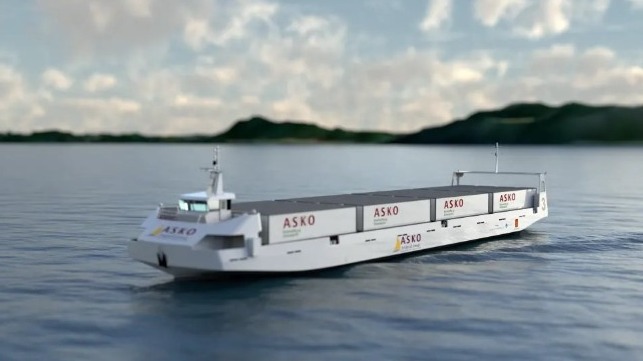An Early Look at ASKO's Autonomous Freight Ferries

Norwegian grocery distributor ASKO is investing in one of the most remarkable vessel projects of the decade. With help from the Kongsberg / Wilhelmsen joint venture Massterly, ASKO is ordering two fully autonomous, electrically powered freight ferries for a route across the Oslofjord. By creating a new private ferry service, ASKO will save the fuel, pollution and man-hours needed to drive freight trailers on a circuitous route between two of its facilities. In addition, the groundbreaking investment will demonstrate the integration of multiple automated systems in one unified platform, taking trailers from one staging area to another with minimal human input.
The Maritime Executive recently caught up with three experts from Kongsberg to discuss this project, including An-Magritt Ryste, Product Director, Next Generation Shipping; Pål Andersen, Technical Director Autonomy, Integrated Solutions / Emerging Projects; and Lars Kristian Moen, Sales Director, Advanced Maneuvering and Autonomy.
TME: Can you tell us a bit more about the route for the new ASKO ferry? Its marine traffic patterns, prevailing currents, etc.?
LKM: The ASKO vessels will operate between Horten and Moss, a distance of about five nm with a transit time of approximately one hour. There is significant commercial traffic to and from Oslo, Drammen and other ports, and lots of leisure boats, especially in summertime. The ASKO schedules will be coordinated with the VTS operation in Horten. There are no special current / tidal effects, although there may be some extreme seasonal situations where the vessel might not be able to operate.
TME: What terminal facilities are required at each end?
PA: At each end, the facilities supporting autonomous operation will include automatic mooring systems, automatic loading ramps and automatic electrical charging systems. Additionally, facilities for autonomous trailer movements will be installed.
TME: Is the grid infrastructure for vessel charging substantially in place, or is transmission / utility work part of the buildout plan?
LKM: The grid supply is sufficient, but energy storage systems are being considered due to fluctuations in the price of electricity during the day. By using energy storage, electricity can be bought and stored when it is cheaper – at night, for example – thereby reducing costs.
TME: Like Yara’s Yara Birkeland, these new vessels will be used for the shipowner’s own freight. Does this kind of operation serve as a good starting point for introducing autonomy? With fixed cargoes, fixed routes and one stakeholder?
A-MR: There are several benefits with these cases, making them ideal as pioneering projects. Firstly, keeping within national waters is a great advantage. There is a lot of goodwill required from several parties – such as the flag state, coastal administrators, other legislators, owners, classification societies and the government – to make these projects a reality.
Secondly, fixed routes yield benefits such as control of necessary infrastructure at either end, and the ability to optimize both the battery dimensions and the hull design, accommodating the cargo need whilst delivering optimal fuel consumption. These operational areas are well known when it comes to sea conditions and expected traffic patterns, parameters greatly contributing to increasing the efficiency of simulators during development efforts and for acceptance of new technology.
TME: ASKO has been investing heavily in decarbonizing its trucking operations, but this is its first foray into zero-emissions shipping. Do Kongsberg / Massterly foresee similar projects for other nontraditional shipowners in the near future?
A-MR: We have seen a tremendous increase in interest since the announcement of Yara Birkeland back in 2017. Prior to this, there was a lot of talk about autonomous vessels – now we see contracts being signed in all the major maritime hubs across the globe.
Where traditional shipowners tend to take a more incremental approach, non-traditional shipowners are either interested in a highly digital offering or go directly towards autonomous operation. Also worth noting is the increasing trend towards automating a larger part of the entire logistical chain, where the vessel constitutes a small part. In a few years, we will see more efforts towards realising smart ports and requests focused on the entire value chain.
TME: Should first movers in this space expect a solid return on investment on their first projects? Or are the benefits primarily in reducing CO2 emissions, R&D, building operating experience, etc.?
PA: As with other technologies, the first movers do not necessarily achieve solid ROI, but a significant reduction of CO2 emissions is achieved. ASKO is also investing in electrical trucks for the transport between the ports and their large distribution facilities.
LKM: Like many new technologies, volume brings better cost savings and return on capital investment, so purely financial benefits will follow as the number of autonomous ships increases and the concept is expanded to new regions and routes. However, there are a number of other driving factors, many of which may also deliver cost savings. Road transport regularity is not satisfactory, and can lead to costly delays. As regulations tighten, we are likely to see CO2 emission costs increase. And – harder to quantify – companies adopting these kind of technologies earn a reputation as innovators, boosting their green credentials and attracting positive media exposure.
